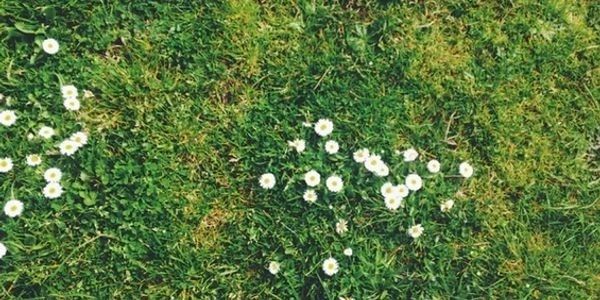
Broadleaf Weeds
ANNUAL FLEABANE

Annual Fleabane – has leaves that alternate and are simple oblanceolate to linear. Annual Fleabane is similar to rough fleabane, but has more leaves and is taller. The root of fleabane is a taproot to fibrous. Annual fleabane has an upright growth habit. Annual fleabane flowers in the spring through the summer. Annual fleabane’s flowers consist of white ray flowers with yellow centers (similar to a daisy), and form in clusters. Annual fleabane reproduces by seed.
BEDSTRAW

Bedstraw, also called catchweed – is a winter annual. The leaves of bedstraw are formed in whorls containing 6 – 8 leaves around square stems. The leaves are narrow to lanceolate in shape with bristles along the edges. Spines at the base of leaves allow bedstraw to cling to objects. The stems of bedstraw are weak and form mats of plants.
BIRDSFOOT TREFOIL
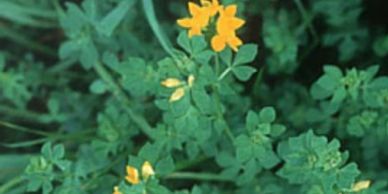
Birdsfoot Trefoil – is a perennial weed, which has a low mat-forming growth habit. The leaves of birdsfoot trefoil alternate on the stems, forming in a trifoliolate pattern, but containing 2 leaflets at the base of the leaf. The leaves are an oblanceolate shape and usually have smooth edges. The stems of birdsfoot trefoil are square at the top and round at the base. Birdsfoot trefoil has a tap root and develops rhizomes and stolons. The flower of birdsfoot trefoil is yellow and forms in the typical legume shape. The plant flowers in late spring and blooms throughout the summer. The seed pod is cylindrical and shaped like a birds foot. Birdsfoot trefoil usually spreads by seed that germinates in the spring, but can also spread by rhizomes and stolons to form dense patches. The top of the plant browns with frost in the fall and will die back to ground level. Birdsfoot trefoil is often confused with large hop clover.
BLACK MEDIC
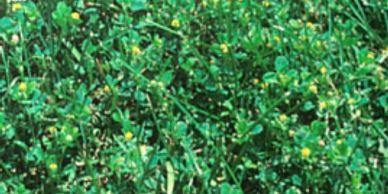
Black Medic – is normally a summer annual, but can act as a perennial in some conditions. It has a tap root, and spreads low to the ground, but it does not root from nodes on the stems. Black medic is more active on soils low in nitrogen fertility. The leaf is similar to clover and other legumes, having three leaflets. Black medic’s center leaflet is on a separate petiole. The flower of black medic is a compressed cluster of bright yellow flowers in the shape of a globular spike on short branches. The seed pod will turn black at maturity. Black medic produces viable seed under normal mowing conditions.
BRISTLY MALLOW
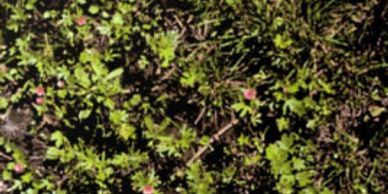
Bristly Mallow – is a creeping perennial with shiny, light green leaves which alternate on the stem. Bristly mallow will root at nodes along the underside of the stems which appear as knobs. The leaves are similar to Venice mallow, but have more lobes on the leaf: six to seven versus three to five on Venice mallow. The margin of the leaves is toothed. Bristly mallow has a deep strong taproot. The flower of bristly mallow is an orange-red in color and appears in late spring to early summer. The flower is cup-shaped and is located at the junction of the stem and leaf. Bristly mallow spreads by seed and by stoloniferous stems.
BROADLEAF PLANTAIN
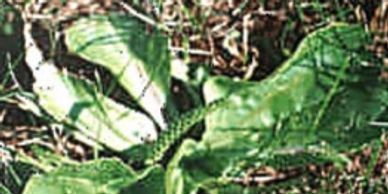
Broadleaf Plantain – is a shallow mostly fibrous-rooted perennial. The leaves which develop in a rosette are large oval-shaped with predominant veins. Broadleaf plantain is similar to several other plantain species but does not have the purple color at the petiole of the leaves. The main growth period for broadleaf plantain is from June through September. The seed head is described as a rat-tail like seed head with flowers along the upper half of the seed head. Broadleaf plantain spreads by both seed and shoots from the roots.
BUCKHORN PLANTAIN
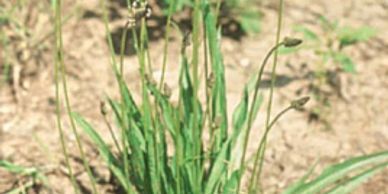
Buckhorn Plantain – is a slender fibrous-rooted perennial. The leaves develop in a basal rosette. They are long slender leafs approximately one inch across. The leaves have distinctive parallel venation. The main growth period for buckhorn plantain is from June through September. The seed heads are cylindrical spikes found at the tip of erect, leafless stalks which are 4 – 12 inches long. The stalks can be hard to cut with mowers. Buckhorn plantain spreads by seeds and shoots from the roots.
BULL THISTLE

Bull Thistle – is a biennial. It grows over the summer months. The leaves are alternate; blades are simple and form in a rosette. The leaves are unlobed to pinnately lobed. The blade tip is pointed and the margins are toothed with spines. The root is a fleshly taproot the first year and a fibrous root system forms the second year. The second year of growth, thistle stems elongate. The elongated stems have alternating leaves. Flowers are present from June through October on the elongated stems. The disk flowers are dark pink to purple with spined bracts. Bull thistle spreads by seeds.
BURCLOVER

Burclover – is a perennial which is very similar in appearance to a black medic. It contains three oblong leaflets, the center leaflet being on its own petiole. The leaflets often have brown spots on the upper surface. The flowers of burclover are yellow. Burclover reproduces by seeds from “burred” seed pods as well as spreading prostrate stolons which allows bur clover to tolerate close mowing.
CARPETWEED
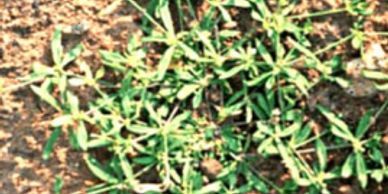
Carpetweed – is a summer annual with smooth prostrate branching stems forming circular mats. The leaves are light green in color, lanceolate in shape, being widest in the middle of the leaf and narrow at the tip and base. The leaves form in whorls containing 3 – 8 leaves. The flowers are white, contain five petals, and form clusters of two to five flowers. The clusters of flowers are formed in leaf axils. Carpetweed spreads by seed.
CHAMBER BITTER
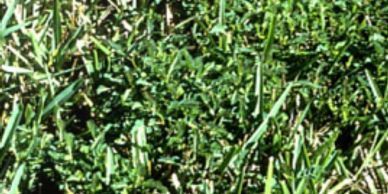
Chamber Bitter – is a warm season annual. The stems of Chamber Bitter are upright and grooved. The leaves are small and have smooth margins which are arranged oppositely on branchlets. Flowers are inconspicuous and form in warm weather. The fruit of Chamber Bitter is green and form on the underside of the branchlets. The seed explodes and spread seeds in the surrounding area. Chamber Bitter reproduces from seed.
CHICORY
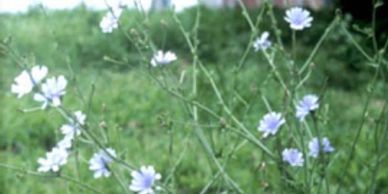
Chicory – is a summer perennial that develops from a basal rosette. chicory looks similar to dandelion in the rosette form, but the lobes of the leaves are not opposite like those of dandelion. The lobes of dandelion also point toward the base. The flowers of chicory range from bright blue to purple in color. The flowers form on stems that range up to three feet in height. The flowers form from June to October. Chicory reproduces by seed.
COMMON CHICKWEED
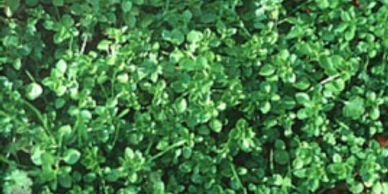
Common Chickweed – is a shallow fibrous rooted winter annual which grows in moist shaded areas. The leaves are small, smooth, pointed at the tip and elliptic in shape. They are opposite on branching creeping stems, which root at the nodes. Chickweed adapts well to different mowing heights. The flowers of common chickweed are white small star like with 5 notched petals. Common chickweed spreads by seed.
COMMON GROUNDSEL
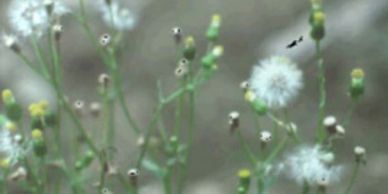
Common Groundsel – is a winter annual member of the aster family. Groundsel has a taproot with a secondary fibrous root system. The sparsely hairy leaves are alternate on upright , many branched stems. The lower leaves are wavy margined to deeply lobed margins. Upper leaves are stemless and coarsely toothed to irregularly lobed. The flowers heads of common groundsel are composed of several yellow disk flowers. Common groundsel is a prolific seed producer. Seeds are produced within several weeks of groundsel germinating, resulting in several generations within the same year. Groundsel reproduces by seed.
COMMON LESPEDEZA
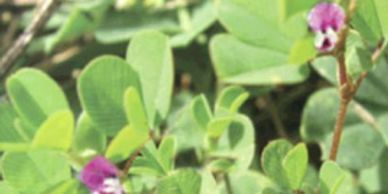
Common Lespedeza – is a prostrate growing summer annual. Three oblong, smooth leaflets, all joining on a common petiole, have a prominent mid-vein. Stems are wiry, prostrate and freely branching. The flowers of common lespedeza are pink to purple and are found in the leaf axils. Lespedeza is commonly found on soils with low fertility.
COMMON MULLEIN

Common Mullein – also called woolly mullein due to the grey hair that covers its leaves, is an erect biennial most commonly found in pastures and along roadsides. Common mullein will invade landscape beds. Common mullein grows to height of three to six foot tall the second year, emerging from a basal rosette which forms from seed the first year. Leaves are elliptic to oblanceolate, covered with gray woolly hair and spiral alternately around an unbranched stem, decreasing in size near the top. Common mullein has a fleshy taproot. The five-petaled flowers of common mullein can be yellow or white. Flowers emerge near the top of the plant where they are crowded along the stalk. Fruit form from October to March in ovoid capsules which split in half to release several seeds. Common mullein spreads from seed.
CORN SPEEDWELL

Corn Speedwell – is a winter annual that germinates in mid-fall. Speedwells have a short tap root to fibrous root systems and branching upright stems. The lower leaves are near round with toothed margins. The upper leaves are more pointed. The plant is covered with fine hairs. Corn Speedwell flowers are small and white to blue in color. The flowers are found in the leaf axis and the seed develops into a distinctive heart shape.
CREEPING BEGGARWEED
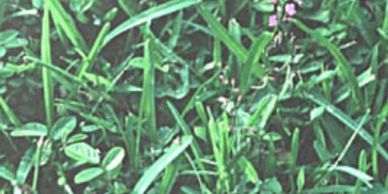
Creeping Beggarweed – is a perennial weed that develops from a large taproot. Creeping beggarweed has many branched runners capable of rooting at nodes along the stems. Leaves are composed of three leaflets of varying sizes. The leaflets are elliptic in shape, pointed at the tip and rounded at the base. Both the stems and leaves are hairy. The flowers of creeping beggarweed are pink to rose in color. The fruit is composed of a segmented seedpod with 6 segments that will separate and attach to clothing. Creeping beggarweed spreads by seed, stolons or segments of the taproot.
CREEPING WOODSORREL

Creeping Woodsorrel – is similar to yellow woodsorrel (Oxalis stricta), but is a creeping summer perennial. The leaves of Creeping Woodsorrel are deeply lobed, heart shaped, and may be green to reddish purple. Creeping Woodsorrel contains a slender taproot, and roots at nodes along slightly hairy stems. The flowers of oxalis corniculata are yellow, contain 5 petals, and form in clusters of 1 – 5 at the end of slender stems. Creeping Woodsorrel spreads by seeds.
CRIMSOM CLOVER
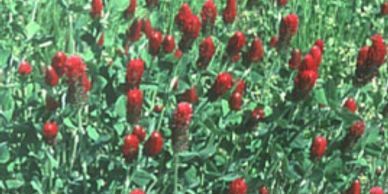
Crimsom Clover – is a cool-season annual. It grows to a height of 12 – 20 inches. The leaf of crimson clover is about the size of red clover. It is light green in color and covered with soft hair. The trifoliolate leaves are usually unmarked but can sometimes contain a few dark-red spots. The plant generally has minimal branching. The flower is a showy crimsom/burgundy flower. The flower head is approximately one inch in length and consists of 40 – 50 individual flowers. Crimsom clover spreads by seed which is produced during the spring to early summer.
CUPID-SHAVING-BRUSH

Cupid-Shaving-Brush – is a warm season invasive exotic annual. The stems of Cupid-shaving-brush are upright, pubescent at the base and smooth at the top. The stems can reach a height of 12 – 18 inches. The leaves have toothed margins and are mainly basal. Leaves that form on the upright stems alternately. Basal leaves have petioles, whiles the leaves that form on the stems contain no petioles, are wider at the base and clasp the stem. Cupid-shaving-brush forms from a tap root. Flowers are formed in warm weather. The flowers are bright red to crimson or scarlet. The flower forms on long stems and contain 2 – 3 heads on each flower stalk. Cupid-shaving-brush reproduces from seed.
CURLY DOCK
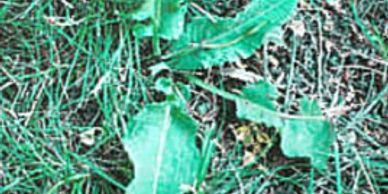
Curly Dock – is a winter perennial. It contains a deep fleshy tap root. In a turf situation the leaves appear in a rosette form. The leaves are actually alternate at the top of the tap root. The oblong leaves have a wavy appearance on their edges. The flower of curly dock is almost never found in mowed turf situations. The flower are long green spikes which turns reddish brown on maturity. The flower grows 2 – 3 feet in height and appears from April to July. Due to the lack of viable seed in turf areas, curly dock spreads by root fragments.
DANDELION
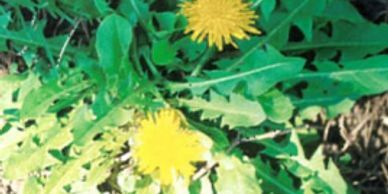
Dandelion – is a winter perennial. The dandelion has thick fleshy tap root which often branches. New plants come from the root and root segments. Leaves form in a rosette, are deeply lobed, with the lobes pointing toward the base. Both the leaves and flower stems contain a white milky fluid. The flowers are yellow and are individual stems. The seeds are brown with tip containing white hairs. The yellow flower will turn to a white globular puff ball. The seeds are disseminated by wind. Dandelions spread by both seed and stems from the root.
DODDER
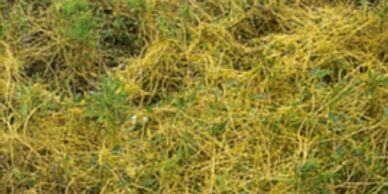
Dodder – an annual plant that consists of thin thread-like stems that are orange in color which attach to a host plant, belongs to the dodder (cuscutaceae) family, which includes many species. At one time dodder was classified in the morning glory family. Dodder is a true parasitic plant. Unlike other parasitic plants such as mistletoe, which have green leaves, only extract water and nutrients from host plants. Dodder has no leaves and must extract carbohydrates from the host plant. Dodder produces small clusters of white to pink flowers in the early summer. Dodder spreads primarily by seeds which have the capability of surviving in the soil up to sixty years. When dodder seed germinates, establishment is dependent upon host plant availability. If a host plant is not within 1 – 3 inches of the initial germinating seed the seedling will die. When the dodder seedling emerges, it develops a small ineffective root which can support the seedling for only a couple of days. Upon germination, the small dodder seedling sways around in search of the host plant. When a host plant is contacted, the dodder coils around the host in a counter-clockwise direction. Small sucking appendages called “haustoria” are produced that penetrate the host plant and extract food. Once the haustoria begin to extract food, the small initial root dies. Dodder can grow up to 3 inches per day and continually produces new haustoria to drain the host plant of nutrients.
DOG FENNEL
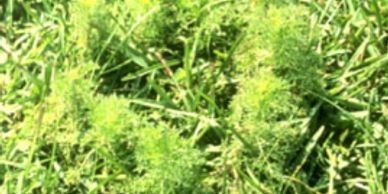
Dog Fennel – is a short-lived summer perennial. The leaves of dog fennel are divided into thread-like segments, giving a fern like appearance. The leaves will omit a foul odor. The stems of dog fennel are reddish in color, hairy and arise from a woody base. The flowers of dog fennel are small and white in color. The flowers are numerous and are borne on branched panicles. Dog fennel spreads by seed, and regrowth from the woody base.
DOVEFOOT
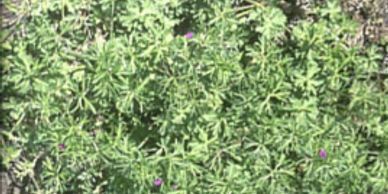
Dovefoot – geranium is a biannual plant very similar to the annual Carolina geranium. Dovefoot geranium has slender, weak hairy stems which branch and spread across the surface of the soil. The leaves are palmately lobed. The alternating rounded leaves of dovefoot geranium are not as deeply cut as the leaves of Carolina geranium. Dovefoot geranium spreads by seeds which germinate in fall into the early spring. Bright dark pink to red violet flowers are present in late spring. The seeds of dovefoot geranium are smooth, unlike the wrinkled seeds of Carolina geranium. Flowers of both plants are borne on stalks from the upper nodes. The fruit of both species are born on conspicuous stalks (cranesbill). The fruit stalk of dovefoot geranium is ¼ inch long and is much smaller than the ½ inch fruit stalk of Carolina geranium.
ENGLISH DAISY
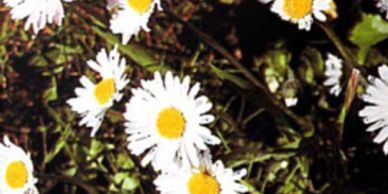
English Daisy – is a perennial whose leaves form a basal tuft or rosette. English daisy has a prostrate or spreading growing habit. The leaf texture varies and may be smooth or hairy. Leaves are narrow at the base and slightly lobed. The English daisy flower is typical of daisies, with white petals and yellow centers, although flowers are sometimes a pink or rose color. Plants have 3 – 4 inch flower stalks. The flower stalks are generally longer than the leaves; stems are smooth and leafless and support a single flower. English daisy reproduces by seed.
FIELD BINDWEED
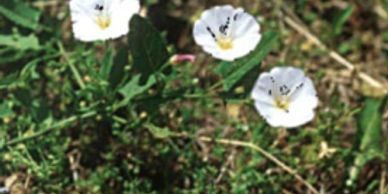
Field Bindweed – is a summer perennial member of the morning glory family. The leaves of field bindweed are arrowhead shaped and appear alternately on long creeping stems. Field bindweed has an extensive root system which may extend up to 15 feet underground. The flower of field bindweed is white to pink funnel-shaped approximately one inch across. Field bindweed spreads by either seed or rhizomes.
FIELD MADDER
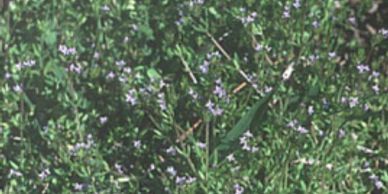
Field Madder – is a prostrate growing winter annual. Due to its growth habit, mats are formed in the turf. The leaves form in whorls around the stem which is square. The leaves are pointed and elliptical in shape. Field madder spreads by seed which is produced in flowers at the tip of the stem. The flowers are pink to lavender in color and occur in the spring.
FIELD PENNYCRESS
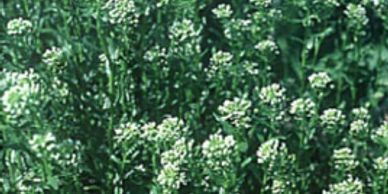
Field Pennycress – is a annual or winter annual weed. Field pennycress initially grows in a basal rosette, but has a erect flowering stem. The auricles at the base of the leaf are pointed. A similar species, throughwort pennycress has rounded auricles. Basal leaves do not remain when the plant matures and the seed stem is produced. Field pennycress spreads by seed. The flowers of field pennycress are white and produced in dense racemes. The seed pods (silicles) are produced along the flowering stem. They are distinctly winged with a notch at the tip.
FILAREE
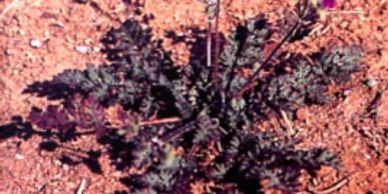
Filaree – are winter annual members of the geranium family. Filaree has a shallow coarse tap root. The feather like compound denselyhaired leaves form from a prostrate basal rosette. The leaves consist of 5 – 9 opposite leaflets which are deeply cut. The leaves of white stem filaree are broader and the leaflets are less deeply cut than red stem filaree. Stems are also hairy, grow low and spreading. The flowers of filarees form umbrella shaped clusters which are pink to purplish in color and contain 5 petals. Filaree reproduces by seed.
FLORIDA PUSLEY
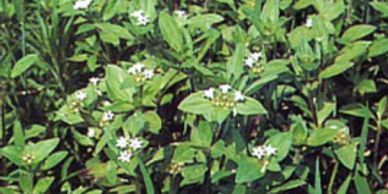
Florida Pusley – is a summer annual found most often in warm season turfgrass areas. The leaves can be hairy and are grow opposite one another on hairy stems. The growth of Florida pusley in maintained turf areas is usually low and prostrate to the ground, forming thick patches. The growth can be erect with infrequent mowing. Florida pusley usually will not root at the nodes. The flowers are white and grow in clumps at the end of the stems. The flower is star shaped with six parts connected to form a tube. Florida pusley will flower anytime the temperature is above freezing.
GROUND IVY
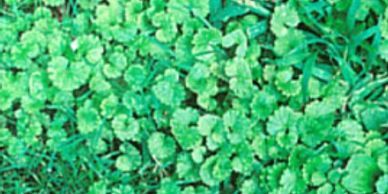
Ground Ivy – is a creeping winter perennial. The leaves are round to kidney shaped with round toothed edges. The leaves are opposite on long petiole attached to square stems that root at the nodes. It is usually found in moist shaded areas, but also tolerate sun very well. Ground ivy will form dense mats which can take over areas of turfgrass. The flowers of ground ivy are blue to lavender and grow in clusters. It usually flowers in the spring. The flowers are funnel shaped and are located at the leaf axis or near the tip of the stem. Ground ivy spreads by stolons and sometimes by seed. Ground ivy closely resembles common mallow.
HAIRY BEGGARTICKS

Hairy Beggarticks – is usually a warm-season annual. It spreads along the ground by stems that root at nodes. The stems are smooth and can be erect. The leaves initially form on long stalks, but following leaves contain up to nine leaflets. The leaflets can have teeth on their margins. Hairy beggarticks spreads by seed and by spreading stems when acting as a short-lived perennial. The flower of the hairy beggarticks has a yellow center with white rays. Flowers are produced until frost occurs. The seeds can attach to clothing and fur on animals.
HAIRY BITTERCRESS
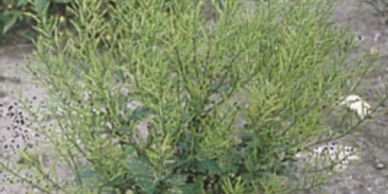
Hairy Bittercress – is a winter or summer annual depending on its location. It initially forms a basal rosette. The initial true leaves are heart shaped, followed by leaves which contain 2 – 4 alternating leaflets. The surface of the leaves is often hairy. Hairy bittercress forms stems that are smooth and erect, usually branched at the base with few leaves. Hairy bittercress spreads by seed. The seed capsule is up to 10 times longer than it is wide. The capsules will project the seeds when disturbed. Hairy bittercress can have multiple generations per year.
HENBIT
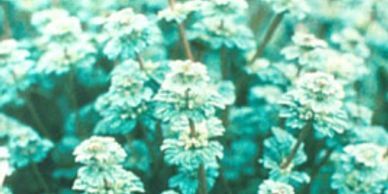
Henbit – a member of the mint family, is an upright winter annual that blooms in the spring. The leaves are rounded on the end with rounded toothed edges that grow opposite one another on square stems Upper leaves lack petioles. Henbit can grow from 4 to 12 inches tall on weak stems. Although an upright plant, weak stems sprouting from the bottom may lay almost horizontal. Henbit can be confused with purple deadnettle. The leaves of purple deadnettle, however, are more pointed at the end and are slightly scalloped. The lower leaves of purple deadnettle are on long petioles, the upper leaves are on short petioles. The flowers of henbit are purple, tubular shaped and form in the whorls of the upper leaves. Henbit spreads only by seed and is generally not a problem in dense, vigorous turfgrass sites.
HORSENETTLE
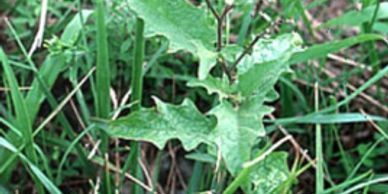
Horsenettle – is a erect perennial weed. The leaves of horsenettle alternate on stems that contain spines. Horsenettle leaves range up to seven inches in length and 1 – 2 inches wide with wavy to coarsely lobed edges. The veins of the leaves as well as the petioles contains spines. Horsenettle spreads by rhizomes and seeds. The flowers of Horsenettle are purple to white in color and occur in clusters on spiny flower-stalks. The anthers of the flower are yellow. Flowers occur during the summer. The fruit is smooth globe shaped; the size of a marble. Fruits are light green in color with green coloring, but turn yellow at maturity.
HORSETAIL
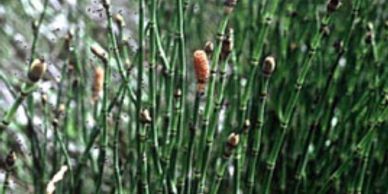
Horsetail – is a perennial weed with deep spreading root stock. Horsetail is most noted by it’s jointed stems which are hollow and will pull apart at the joints. The leaves are small and scale like. They are located at the joints on the stems. Horsetail is found in moist soils along streams, ponds, roadsides and low areas in fields. Horsetail forms dense patches of stems that persist throughout the winter. Horsetail spreads by underground root stock and spores. Horsetail is found throughout the summer months.
HORSEWEED

Horseweed – is an annual weed, winter or summer, depending on location. Horseweed is an upright growing plant and can reach 4 – 5 feet if not mowed. Horseweed grows in a basal rosette. The leaves which are oblanceolate in shape are 3 – 4 inches in length. The leaves alternate and have margins that are toothed. The stem of horseweed is simple and unbranched, and covered with hair. Horseweed has a taproot. The inflorescence is a panicle of heads with pink to white flowers. Horseweed spreads by seed produced in the summer.
KHAKIWEED
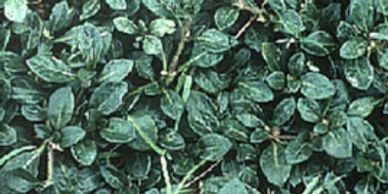
Khakiweed – is a annual or perennial, depending on the location, which develops from a thick tap root. The stems of khakiweed are covered with hair. Khakiweed has a prostrate growth habit. The leaves of khakiweed form opposite and are round to oblong with the tip being the widest part. Khakiweed reproduces from seeds. The flowers are white and form in stiff spiny heads, solitarily, or in groups of 2 to 3. The flowers form at the nodes. Flowering occurs during the summer months.
LAMBSQUARTER
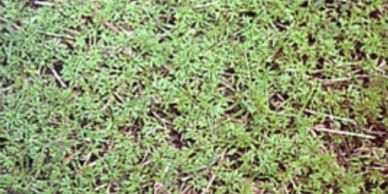
Lambsquarter – is an erect summer annual. The leaves of lambsquarter are lanceolate in shape, approximately 1 – 2 inches in length and about 1 inch wide. The edges of the leaf are toothed and the leaf tip is pointed. The leaves are covered with a white mealy substance, especially on the underside of the leaf. The leaves form alternately on the stems. The root of lambsquarter is a branched taproot. The flowers of lambsquarter are found in small green clusters and lack petals. The clusters of flowers form in terminal spikes. Lambsquarter spreads by black seeds that germinate in the late spring to early summer.
LAWN BURWEED

Lawn Burweed – (spurweed) is a low growing winter annual which forms mats due to branching. The leaves are opposite and divided into narrow segments or lobes. The flowers are small and inconspicuous. The fruit forms in the leaf axils with sharp spines. Lawn burweed reproduces by seed.
MATCHWEED
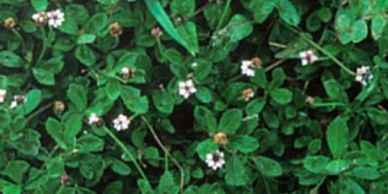
Matchweed – also called mat lippia, is a matforming perennial with opposing leaves on hairy branching stems. Leaves have small teeth at the outer tip. The purple to white flowers emerge around the tip of the seed stalk forming a match-head appearance. Matchweed spreads by both seeds and stolons along prostrate stems.
MOSS
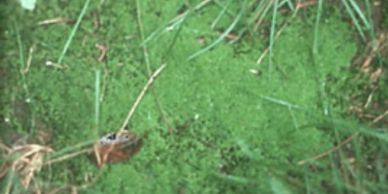
Moss – is a primitive plant; most species are perennial. Moss has a filamentous growth pattern and produces a felt-like mat over the soil surface. This moss mat can become thick under good growing conditions. There are two main groups of moss species. The first contains chlorophyll and grows on the soil surface; the second lacks chlorophyll and spreads underground. These groups can be divided again by their growth habits. Moss is different from higher plants such as turfgrass, because it does not contain conductive tissue and lacks phloem and xylem. Due to not having conductive tissue, moss also lacks true roots, but absorb moisture and nutrients through root like structures called rhozoids. Leaves of most moss species are only a few millimeter long and lack petioles.
NIMBLEWILL
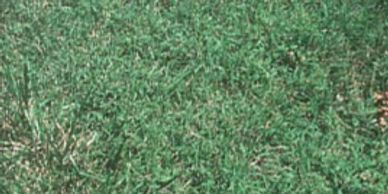
Nimblewill – is a perennial grass that browns in the winter. Nimblewill produces short stolons, but no rhizomes. The leaves are rolled in the bud, the ligule is short, membranous, toothed at the top, and auricles are absent. The leaf blades are narrow and white-green in color. Nimblewill forms patches and is fairly tolerant of shade. The seed head is a loose spike-like panicle.
OXEYE DAISY

Oxeye Daisy – is a perennial weed. The stems grow erect and can range in height from 10 – 24 inches. Oxeye daisy initially forms a rosette. The basal leaves are hairless, lobed or toothed on the margin When the stems form, the leaves form alternately and decrease in size higher up on the stem. Oxeye daisy spreads by both seed and by short rhizomes. It forms in clumps or patches. The roots are fibrous along with the short rhizomes. White flowers are produced from June through August. The flowers from in a composite shape with white ray flowers surrounding yellow disk flowers. The upper stems usually die back over the winter, but basal leaves may remain green in milder climates. ts on the upper surface. The flowers of burclover are yellow. Burclover reproduces by seeds from “burred” seed pods as well as spreading prostrate stolons which allows bur clover to tolerate close mowing.
PALESEED PLANTAIN
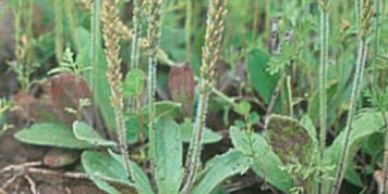
Paleseed Plantain – is a winter annual, sometimes a biannual. The leaves form in a basal rosette. The leaves are oblanceolate in shape, usually having smooth edges, soft hairs and ranging from 2 – 4 inches in length. Paleseed plantain forms a taproot. Paleseed
plantain spreads from seed that is produced from flowers present in late spring. The seedhead is formed in a rat tail shape similar to broadleaf plantain.
PARSLEY-PIERT
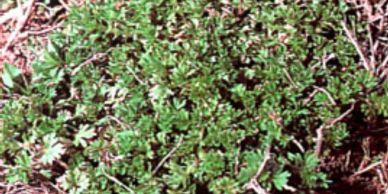
Parsley-Piert – is a low growing winter annual. The fan shaped hairy leaves alternate on the stems. The leaves contain three lobes and each lobe is subdivided again into 3 – 4 lobes. The flowers are inconspicuous in the leaf axis. Parsley-piert spreads by seed.
PENNYWORT
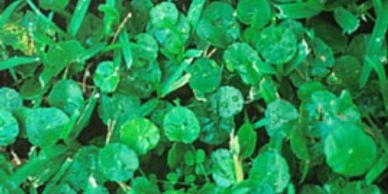
Pennywort – also called dollarweed, is a summer perennial weed. The leaves of pennywort are round in shape, approximately 1 inch in diameter. The dark green leaves are glossy, with scalloped edges and are on long slender petioles. The petiole of pennywort is attached to the center of the leaf, not to be confused with dichondra in which the petiole is attached to the edge of the kidney shaped leaf. The pennywort flower is small with 5 white petals and forms in clusters on the end of long stems. Pennywort spreads by seed and rhizomes.
PINEAPPLE WEED
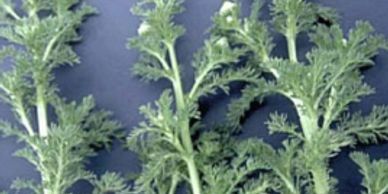
Pineapple Weed – is a summer annual. When the plant is crushed, it has the odor of a pineapple. The hairless leaves are divided into very narrow segments, and are arranged alternately on the stems originating from a taproot. The plant has a bushy growth habit resulting from branching from lower stems. Flowers which are yellow in color are produced from May through August. One to several flowers are produced at the end of short stems. Pineapple weed spreads by seed.
POISON OAK
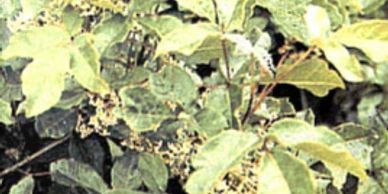
Poison Oak – is identified by 1 ½ to 3 inch long leaflets with two to seven deep lobes resembling oak leaves. Lateral leaflets appear without stalks on viny stems about 3 to 4 feet tall. Like poison ivy, leaflets are grouped three per leaf, and flowers are yellowish.
PRICKLY LETTUCE

Prickly Lettuce – also called wild lettuce or compass plant, is a winter annual. The leaves form in a basal rosette. Prickly lettuce has a deep tap root which will exude a milky sap. Prickly lettuce will produce an upright stem on which the leaves will be alternate. The mature leaves are deeply lobed. The leaves will twist vertical to the stem. The leaves have a row of spines along the mid-vein of the lower surface. The flowers of prickly lettuce are yellow in color and approximately one third of an inch in diameter. Flowers are produced in late spring to early summer. Prickly lettuce reproduces by seed.
PROSTRATE KNOTWEED
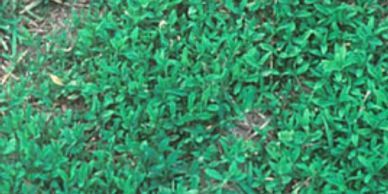
Prostrate Knotweed – is a summer annual, which forms dense patches. Prostrate knotweed is probably the earliest of the summer annuals to germinate in the spring. Prostrate knotweed is often confused with first-leaf crabgrass. Prostrate knotweed is a prostrate weed that produces a thin tap root and multiple branched stems. Even though knotweed does not root down at the nodes of the stems, a single plant can form a dense mass up to three feet across. Prostrate knotweed tolerates extremely compacted soils and is often found in high traffic areas. The leaves appear alternately on the stems, and differ in the color of green depending on the age of the leaf, with older leaves being a less intense green. The stems will be knotty and have a paper like sheath.
PUNCTURE VINE
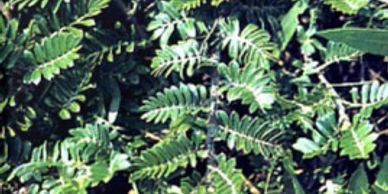
Puncture Vine – is a summer annual. The leaves are opposite and even-pinnately compound composed of 8 – 16 hairy leaflets. The stems are prostrate mat forming originating from a taproot. The flowers are solitary, consisting of 5 yellow petals, and are found in the leaf axils. The fruit which contains 1 – 4 seeds contains 2 – 4 spines. Puncture vine spreads by seed which can remain viable for years.
PURPLE (OR RED) DEADNETTLE

Purple (or red) Deadnettle – is a winter annual often confused with henbit (Lamuim amplexicaule). Both weeds have square stems and belong to the mint family. The leaves of purple deadnettle are triangular in shape and less deeply lobed than henbit. The upper leaves of deadnettle are red to purple in color. The leaves of purple deadnettle have petioles with the petioles of the lower leaves being longer than the upper leaves. The flowers of purple dead nettle are light purple in color. The flowers are arranged in whorls and form in the axis of the upper leaves. Purple deadnettle spreads by seeds.
PURSLANE
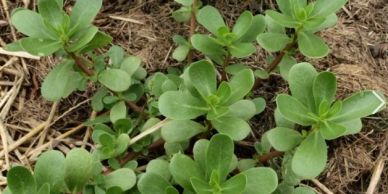
Purslane – is a summer annual with prostrate growth from a tap root and fibrous surface roots. The leaves are thick and waxy, resembling a Jade plant. The leaves usually alternate, with a cluster at the tip of the stem. Stems are thick, red in color, and branch out from a central point, forming a mat up to 1 foot in diameter. The flower is solitary, yellow in color and has 5 petals. The flower is found in the leaf axis or at the tip of the stem. Purslane flowers from May to November and spreads by seeds, which germinate in the spring, or by stem fragments.
RABBITFOOT CLOVER
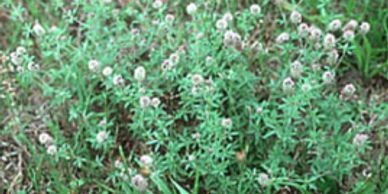
Rabbitfoot Clover – is a winter annual. Rabbitfoot clover has a multi-branched growth habit. Both the stems and leaves are densely haired. The leaves consist of 3 narrow leaflets with minute teeth-like projections at the tips. The flowers of rabbitfoot clover are small pink to purple and are clustered in grayish soft-silky cylinder-shaped heads. Rabbitfoot clover reproduces by seed, and flowers in the spring.
RED SORREL
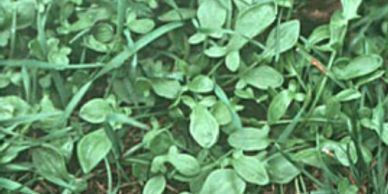
Red Sorrel – also referred to as sheep sorrel, is a summer perennial. The leaves alternate and form a basal rosette. The older leaves are arrowhead shaped with two basal lobes attached to a petiole. Leaves formed along the stem are more elongated and usually lack the basal lobes. The margins of the leaf are smooth. The leaves become thick and fleshy over the summer months. The root red sorrel is a shallow yellow taproot, combined with multiple rhizomes. Flowers are produced from May to September. Male and female flowers are produced on separate plants. The male flowers are yellow-green and the female flowers are reddish-brown. The flowering stems of red sorrel can be one or many developing from a crown or rhizome. Red sorrel spreads by seeds and rhizomes.
SANDBUR
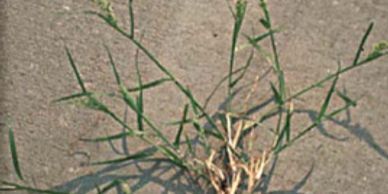
Sandbur – is a summer annual grass. Sandbur forms clumps due to lack of rhizomes and stolons, but can root at nodes on the stems if they touch the ground. The leaves are folded in the bud, the ligule is a fringe of hairs, auricles are absent. The plant turns brown in winter. The seedhead of sandbur consists of a spike like raceme containing spined or burredseeds. The seeds catch on clothing or animal fur.
SPREADING DAYFLOWER
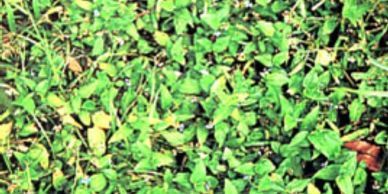
Spreading Dayflower – is an annual with multiple branches that spreads by taking root from nodes along stems. Stems are smooth with lance shaped leaves in sheaths having a few soft hairs. Flowers have three blue petals, two of which are partly fused. Flowers last one day, giving the plant its common name. Dayflower reproduces from seed and from nodes along stems. Stem fragments will also reproduce. Dayflower prefers rich, moist soil conditions.
VENICE MALLOW
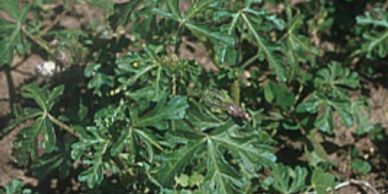
Venice Mallow – is a summer annual. It was introduced from Europe where it was grown as an ornamental. Venice mallow has an upright growth habit and can reach 10 – 18 inches in height. The stems are erect, covered with hairs and branch from the base. The leaves are deeply cleft into 3 – 5 coarsely toothed lobes and form on long petioles. The lower stems and petioles can be a red to purple in color. Venice mallow has a fibrous root system with a weak taproot. The flower of Venice mallow is very showy and are a light sulfur-yellow color with a deep red to purple center. Venice mallow is nicknamed “flower-of-an-hour” because flowers will only last several hours before the petals drop. Venice mallow spreads by seed. The seeds can lay dormant for up to 50 years.
VIRGINIA BUTTONWEED
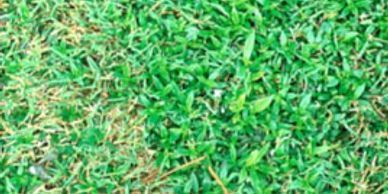
Virginia Buttonweed – is a prostrate growing perennial with branching hairy stems. The leaves are elongated, lance-shaped and grow opposite one another on the stems and are joined by a membrane. Virginia buttonweed prefers moist, wet conditions. The tubular flowers of Virginia buttonweed are white to purplish and grow in the leaf axils along the stem. Flowers resemble four-pointed stars. Virginia buttonweed spreads by seed and plant segments.
VIRGINIA PEPPERWEED
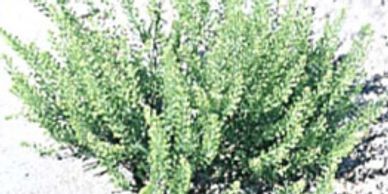
Virginia Pepperweed – or peppergrass, is a winter annual. The lower leaves of Virginia pepperweed form from a basal rosette, and are deeply lobed. The stem of Virginia pepperweed is erect and freely branched. The mature plant does not contain any basal rosette leaves, and the leaves on the stem are alternate and more lanceolate than the basal leaves. The flower of Virginia pepperweed is produced from Maythrough early summer. The flowers are whiteand form in a finger-like cluster or bottle-brush at the top of the plant. The seeds of Virginia pepperweed germinate in late summer or early fall. Limited germination occurs in the spring.
WHITE CLOVER
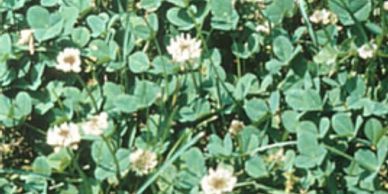
White Clover – is a shallow rooted winter perennial legume which spreads by stolons or above ground runners. The plant takes root from the stolons at nodes along the stems when they come in contact with the soil. The white clover plant has compound leaves divided into three leaflets which are all joined at a central point and originate at the nodes along the stems. Leaves may contain a white ‘watermark’. White clover is adapted to many soils but tends to grow best in soils that are moist and low in nitrogen.
WHITE PRAIRIEASTER
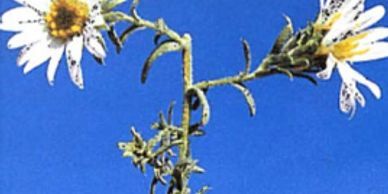
White Prairieaster – as well as purple aster and hairy golden aster, is a perennial weed which can reach 1/2 to 2 feet tall in non-turf situations. Purple aster and hairy golden aster reproduce by seed only; white prairieaster, however, also reproduces by creeping underground roots. Some asters have more sparse or dense hairy leaves and may be fleshy or firm with a linear lance shape. Stems have many branches. Flowers of asters are clustered at the ends of the branched stems and appear from July through October. Asters, especially white prairieaster, can become a competitive problem in turf areas where soil conditions are moist, especially in heavy clay soils.
WILD CARROT
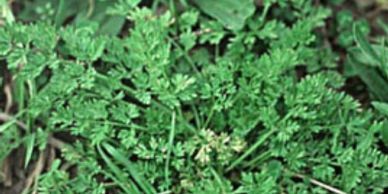
Wild Carrot – or Queen Anne’s Lace, is a biennial. During the first year, lacy fern like leaves develop in a basal rosette form. The leaves are compound with multiple leaflets. Wild carrot has a slender woody taproot. The flowers of wild carrot are small and white. The center flower in the clusters is first to bloom and is usually purple. The flower forms in flat umbrella shaped clusters, 3-6 inches in diameter, called umbels. The hollow flower stalks develop in the second year, and stand 2-4 feet high. Wild carrot reproduces by seed.
WILD GERANIUM
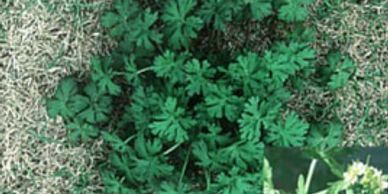
Wild Geranium – also called Carolina geranium, is a semi-erect winter annual. The erect stems are branching and covered with hair. The alternate leaves are on long petioles and are divided into segmented leaflets which are blunt-toothed. The flowers have 5 white to pink petals and form in clusters. The seed forms in a fruit capsule that forms a “storks bill”.
WILD ONION AND WILD GARLIC
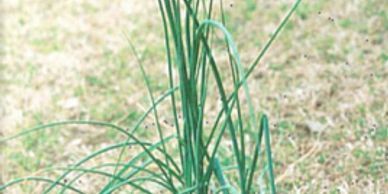
Wild Onion and Wild Garlic – are both winter perennials. The leaves are waxy, upright and needle shaped growing 8-12 inches long. The leaves of wild garlic are hollow and round and have a strong odor. The leaves of wild onion are solid and flat and appear directly from the bulb. Both plants grow from underground bulbs. The membrane-coated bulbs of wild garlic are flattened on one side and have bulblets. Wild onion bulbs are white inside with a strong odor and are covered with a fibrous, scaly coat.
YELLOW AND ORANGE HAWKWEEDS
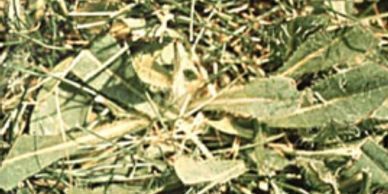
Yellow and Orange Hawkweeds – The vegetative characteristics are similar, but the color of the flowers is different. Hawkweeds are winter perennials. Hawkweed grows from a basal rosette, forming patches from rhizomes and stolons. The leaves, stems and flower stalks are covered with hair. The leaves are oblong and club shaped. The margins of the hairy leaves are smooth. Hawkweed flowers resemble dandelions, but are smaller and appear several weeks after dandelions. The flowers form in clusters.
YELLOW FOXTAIL
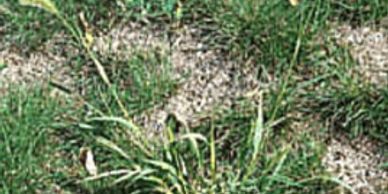
Yellow Foxtail – is a summer annual which germinates when soil temperatures reach 65 degrees F. The leaves are rolled in the bud. The ligule is a fringe of hairs, and the auricles are absent. The collar is narrow and continuous. The blades of yellow foxtail contain hairs near the ligule. The growth habit of yellow foxtail is erect. The seedhead is a bushy, erect spike which resembles the tail of a fox.
YELLOW THISTLE
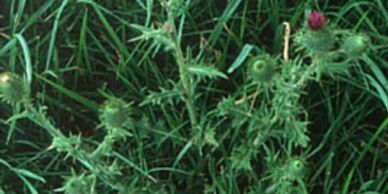
Yellow Thistle – is a winter annual or sometimes a biannual. The initial leaves form in a rosette. The mature leaves contain large toothed and cut lobes. The mature leaves are very spiny. Yellow thistle spreads by seeds attached to tuffs of soft white hairs which help in the spreading of the seeds. The flowers are produced in the late spring and seeds are produced over the summer.
YELLOW WOODSORREL
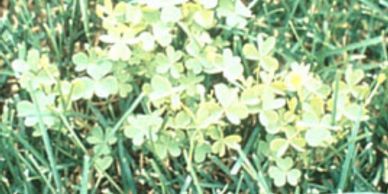
Yellow Woodsorrel – also known as Oxalis, is a summer annual, that can be perennial in some areas. Yellow Woodsorrel grows on weak stems that branch at the base and may root at the nodes. The leaves form in groups of three leaflets on long petioles, and are alternate on the stems. Although sometimes mistaken for clover when not in flower, the leaves differ from clover in that they are distinctly heart shaped. The Yellow Woodsorrel flower is yellow with five petals and occurs in clusters. The seed pods range from 1/2 – 1 inch in length, have 5 ridges and are pointed. Yellow Woodsorrel spreads by seeds which burst from the pods at maturity and may be scatted several feet.
